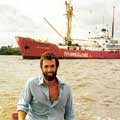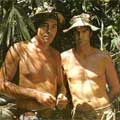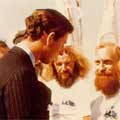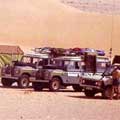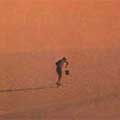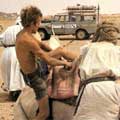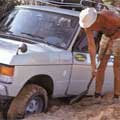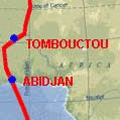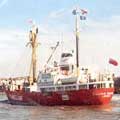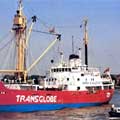Part 1: The Sahara
September 1979 – December 1979
After the Transglobe Expedition had crossed the Sahara Desert and reached Abidjan, Ran Fiennes, its leader, said: ‘I described the stage we had then reached as the end of the beginning’. I was wrong – it was the end of the preparation for the beginning.
“The real beginning was our journey across France, Spain and the Sahara, and the trade exhibitions in Paris and here on the Ivory Coast”. Earlier, in one of his communiques, he had said: “To provide an account of the action to date would be like describing a hike along the Pennines. There has been nothing of drama to report.. It was known in advance that a crossing of the Sahara was sufficiently commonplace to make any report hard to justify”.
Of course, he was not entirely right. The photographs show the drama of the scenery through which they travelled and some of the difficulties they encountered.
For crossing the Sahara still has its problems; however many people do it and however often, the heat does not get less, the sandstorms do not diminish in ferocity and frequency, and crossing national boundaries becomes more difficult, not easier. Moreover, Ran and his team were forced by the demands of their scientific programme to stray frequently from the beaten track, and even the Landrovers (for whose performance they are full of praise) occasionally bogged axle-deep in the sand. Unloading to lighten them, digging and towing them out and then re-loading them in temperatures often well over 100 degrees Farenheit (38°C) could not have been amusing.
The first big event of the Expedition was, of course, sailing from Greenwich with HRH the Prince of Wales inaugurating the venture. All concerned with the Expedition, members and sponsors alike, were deeply grateful to him for fulfilling this engagement at a time when the Court and the country alike were in deep mourning for the death of Earl Mountbatten. But the Prince explained that he had done so because “it was an enterprise of which Earl Mountbatten would have thoroughly approved”.
At the Paris trade exhibition, which followed, no fewer than 225 of the Expedition’s sponsors displayed their goods, including examples of the equipment to be used. The “land party” (Ran and Virginia Fiennes, Simon Grimes, Charlie Burton and Oliver Shepard) then crossed France and Spain in the two Landrovers and the Range Rover to Barcelona, where, unfortunately, the planned trade exhibition had to be abandoned because the roof of the hall had been damaged in a thunderstorm.
At Barcelona they loaded the vehicles and the exhibition equipment (which had come from Paris by rail) into the Benjamin Bowring and sailed for Algiers, where they first began to feel the climate trying – it was in the high nineties Farenheit (35+°C) with humidity ranging around 90 per cent. The insects bit relentlessly and the daily routine of using repellant cream and anti-malarial tablets began. The desert crossing each day began at five in the morning and breakfast consisted of cereal, coffee and bread – no butter because of the high temperatures. Simon Grimes was the cook, Oliver Shepard would pack away the tents and other equipment, fill the canvas water-sacks (those traditional and essential concomitants of travel in Africa) and bury the rubbish deep in the sand. Water was rationed to a gallon a day each, and this had to suffice for cooking, washing, filling up the water sacks, topping the vehicle radiators, and drinking – which took a lot because as the heat increased and the desert air grew drier, fluid intake had to be kept high. During the day rations consisted only of fruit and bread.
Sandstorms, lasting from one to three hours, were quite frequent and hindered progress as well as being uncomfortable. They took no rest during the day, but all spelled each other at driving, changing vehicles frequently in order to break the monotony. At about five each evening they stopped for the night. Simon would get out his pots and pans and start cooking, Oliver would again record his meteorological observations, they would set up the tents and hurriedly eat a meal of soup, tinned or dehydrated meat, tinned vegetables and dried potatoes -hurriedly because by six o’clock it would be dark. Insects -some disconcertingly large – bothered them throughout the journey. Charlie Burton had one night to evict a huge spider from his bedroll – but they managed to evade the scorpions, though at El Golea a medical orderly told them that three people had recently died there from scorpion stings.
There were water supplies along the route. But all the water had to be strained and boiled, and more than once they could quite clearly see would-be parasites wriggling in the gauze. Simon Grimes, being in charge of the commissariat, bought bread, fruit, onions, yams and ground-nuts whenever he could, but a share-out of the cost at the end of the eight weeks of the crossing revealed that he had only been successful to the extent of £1 per head. Among the more acute discomforts were the thorny burrs from the wild grasses that grow in the El Golea region, which, they said “stuck to everything, got under our clothes and caused sores”.
At Timbuktu, fed up with the monotony of Simon’s hurriedly re-hydrated cooking, they decided on the luxury of a “restaurant” meal. It started well enough with sardines which are apparently flown there from Agadir as a delicacy. The next course was to be chicken, which the “chef” supplied by simply catching the first scrawny hen that was foolhardy enough to come near him. He then plucked it, alive, in full sight of his guests and in spite of its piercing protests.
“Our appetite”, said Virginia, “flew away with the feathers”. Throughout the journey Oliver, aided by the others whenever they could be spared, was busy collecting specimens for the British Museum Natural History Section. Most frustrating were the bats they had asked for, which were only captured after four days of climbing about in wells and caves. Close second came a lizard called a zelgaag, which “swims” through the sand so fast (said Oliver) that you have to “dig like a maniac” to catch up with it. South of the Sahara the climate becomes more typically tropical and the vegetation greener and lusher. In the swamps of the Niger basin Oliver made forays in a collapsible boat powered by a British Seagull outboard. Ran Fiennes filmed him doing it. At Abidjan the Benjamin Bowring, faithful as ever, was awaiting them. They mounted their trade exhibition, re-loaded her and left for Cape Town. The Sahara crossing proved a useful “run-in” for the Expedition. The equipment, to use Ran Fiennes’ words, “served extremely well”, and the vehicles “proved entirely troublefree”. The radio, installed in Virginia’s Landrover with a nine-foot whip antenna mounted at the rear, “performed miraculously with clear voice contact daily with the ship and radio station in the United Kingdom”.

